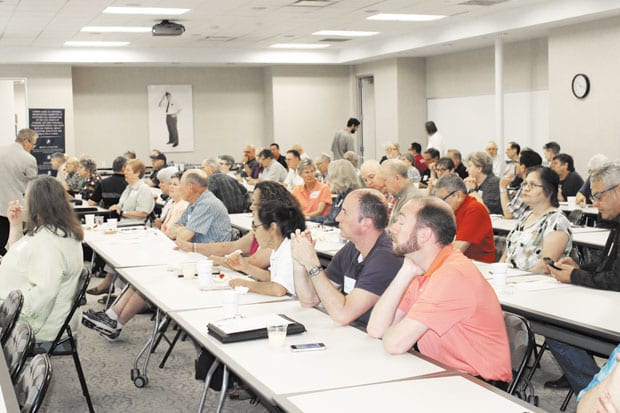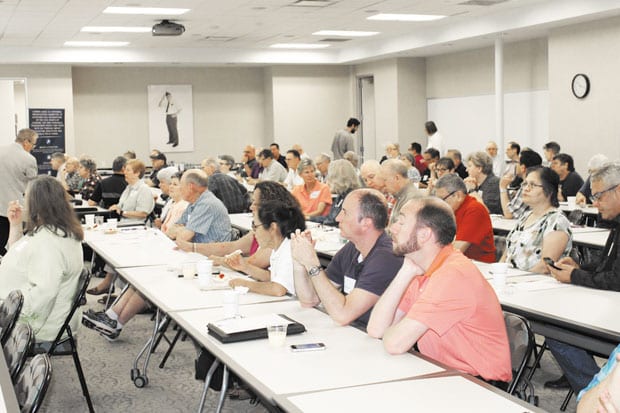
While no one likes talking about getting old, about 200 people did just that at the first LGBT aging summit last summer at Senior Source on Harry Hines Boulevard. The second takes place on July 23 on SMU’s Plano campus. (David Taffet/Dallas Voice)
DAVID TAFFET | Senior Staff Writer
Since its first conference last year, the Coalition for LGBT Aging has been working to improve existing services in North Texas, helping make them more LGBT-friendly.
“We’re not going to duplicate services,” Coalition founder Cannon Flowers said, reiterating that the goal is to make what’s already out there better.
New training has made 211 operators more aware of services available to LGBT people and more sensitive to their needs, which is progress. But there are lots of new services desperately needed by the older LGBT community, Flowers said.
“Housing is the No. 1 priority,” Flowers said. “We need an equality index on senior living facilities.”
On Saturday, July 23, the Coalition holds its second conference on aging LGBT. This year it’s in Collin County, on the SMU Plano Campus, 5236 Tennyson Parkway, Building 4.
The event opens with remarks from Plano Mayor Harry LaRosiliere.
Rather than large plenaries, this year’s conference is concentrating on breakout sessions. Coalition board member Sam Tornabene said panels are planned to discuss four areas of interest — housing, legislation, caregiving, legal, social and transgender issues.
“In the trans community, the issues can be daunting, depending on the level of transition,” Tornabene said.
He said an EMT might provide care that’s degrading or — with the so-called “religious freedom” laws popping up around the country and being debated in Congress — even refuse to care for an LGBT patient.
Other topics that will be addressed are issues of guardianship and what assistance an organization like Senior Source may provide for people who have no one else to act as guardian. Another topic will be the long-term affects of living with HIV, because each year, many people set new records for survival and thriving despite being HIV-positive.
Tornabene said next Texas’ legislative session will be challenging. Not only are a record number of anti-LGBT bills expected to be filed, but aging LGBT people will face the same cutbacks expected for all seniors. To make a greater impact on lobbying days, Tornabene said LGBT groups lobbying on senior issues will go the same day as other senior groups lobbying on those issues.
Tornabene also noted that the conference will include a session on financial planning, adding that the older generation of LGBT people, especially gay men, need to approach such planning differently, since so many didn’t expect to live so long and therefore failed to plan adequately for their later years.
All of the breakouts will be recorded and available later on YouTube.
At its August board meeting, the coalition board will prioritize items and move forward to bolster existing services throughout the area and provide new services when possible, officials said.
According to the American Society of Aging, “Recent research documents social, health, and economic disparities among LGBT elders.” Despite growing visibility for the LGBT community and changes in legal status, the community remains “largely invisible in aging services, policies and research.”
The coalition intends to change that — at least locally.
Second annual Summit on LGBT Aging, 10 a.m.-2 p.m. on July 23 at Southern Methodist University Plano Campus, 5236 Tennyson Parkway, Building 4, Plano.
………………………….
Study looks at health disparities among older LGBs, heteros
From Staff Reports

Cannon Flowers
A recent analysis on health disparities among older sexual minorities indicates that older lesbians, gays and bisexuals seem to take better care of their health than their heterosexual counterparts at least in some areas
The report offers estimates made from data from two years of the National Health Interview Survey, 2013-2014, conducted by the Centers for Disease Control and Prevention.
The study examined differences in 15 health characteristics among sexual minorities — LGB (no T included) — and heterosexuals, all age 65 or older.
Findings were presented in three categories: health characteristics with statistically significant differences, health characteristics with no statistically significant differences and health characteristics with insignificant data to detect differences.
The report’s authors do note that, “Because there were relatively few respondents who identified as sexual minorities, the tests we performed had limited power, and the detectable differences were correspondingly large.”
Information in the report indicates that of the 15,799 respondents, only 147 identified as sexual minorities. Of those 38.4 percent were female and 88.8 percent were white. The mean age was about 72.
(Editor’s note: Obviously, a study that included a broader group of respondents on the sexual minority side of the equation that more accurately represented the true diversity of the LGB community and include the transgender portion of that community would likely deliver far different results.)
In the first group — the one showing statistically significant differences — sexual minorities were more likely to say they are in excellent or very good health than those in the sexual majority, 62.7 percent to 45.9 percent. 79.7 percent of the LGB respondents said they had received a flu vaccine, compared to 68.8 percent of the non-LGBT respondents, and 51.3 percent of the LGBT respondents said they had at some point been tested for HIV, compared to only 15.8 percent of the non-LGBT respondents.
The straights had healthier answers, for the most part, when it came to alcohol use though. Only 6.7 percent of the non-gay respondents said they had five or more alcoholic drinks in one day at some point in the last year, while 14.5 percent of the LGB respondents answered yes to that question.
The second category, the one in which there was no statistically significant difference, included (with the percentage for LGB respondents first): have a usual source for medical care (96.1 to 96.6); current cigarette smoker (9.1 percent to 8.6); trouble seeing (16.7 percent to 13.8 percent); told by a doctor you have cancer (29.1 percent to 23.4 percent); obese (27.7 percent to 26.7 percent); functional limitations (53.4 percent to 64 percent); and told you have coronary heart disease (12.4 percent to 14.1 percent).
This article appeared in the Dallas Voice print edition July 22, 2016.

